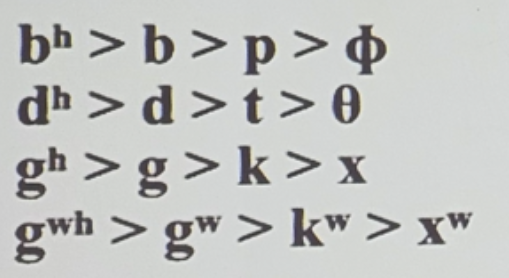history of the English language
1/14
Earn XP
Description and Tags
please end me
Name | Mastery | Learn | Test | Matching | Spaced |
|---|
No study sessions yet.
15 Terms
What is a language family? Describe & give examples
A language family is a group of languages related through descent from a common ancestral language or parental language
• The term "family" reflects the tree model of language origination in historical linguistics,
• Linguists therefore describe the daughter languages within a language family as being genetically related
Explain the notion of tree model in historical linguistics
The tree model posits that all languages evolve from a common ancestral language, much like branches growing from a single trunk of a tree. As populations diverge and develop independently, their languages branch out, forming distinct language families.
What are Indo-European languages? Which languages do not belong to this group?
The Indo-European languages are a language family of several hundred related languages.
• The Indo-European languages with the greatest numbers of native speakers are Spanish, English, Hindustani (Hindi-Urdu), Portuguese, Bengali, Punjabi, and Russian, each with over 100 million speakers,
• German, French, Marathi, Italian, and Persian also having more than 50 million.
notable exceptions include Hungarian, Turkish, Finnish, Estonian, Basque, Maltese, and Sami. (are in Europe, but do not belong to the same branch)
Name at least 5 Indo-European family groups
Balto-Slavic, Celtic, Germanic, Hellenic, Indo-Iranian, Italic
Name languages belonging to West-Germanic group
English, Scots, German, Low German, Yiddish, Limburgish, Dutch, Afrikaans, Frisian
Name languages belonging to North-Germanic group
Swedish, Danish, Norwegian, Icelandic, Faroese
Describe main notions of Grimm’s law
• also known as the First Germanic Sound Shift
• a set of statements named after Jacob Grimm and Rasmus Rask
• establishes a set of regular correspondences between early Germanic stops and fricatives and the stop consonants of other centum Indo-European languages
Proto-Indo-European voiceless stops change into voiceless fricatives.
Proto-Indo-European voiced stops become voiceless stops.
Proto-Indo-European voiced aspirated stops become voiced stops or fricatives (as allophones).

Describe main notions of Verner’s law
Voiceless fricatives f, þ, s, h, hw following an unstressed syllable became the Voiced fricatives ß, ð,z, ɣ, ɣʷ
PIE voiceless stops p, t and k should have - according to Grimm's law - hanged into Proto-Germanic (PGmc) f (bilabial fricative [ɸ]), b (dental fricative[θ]) and h (velar fricative [x]).
unexpected voicing of voiceless stops occurred if they were non-word-initial and if the vowel preceding them carried no stress in PIE.
![<ul><li><p>Voiceless fricatives <em>f, </em>þ, <em>s, </em>h, <em>hw following an unstressed syllable became the Voiced fricatives </em>ß, <em>ð,</em>z, <em>ɣ, </em>ɣʷ</p></li><li><p>PIE voiceless stops <em>p, </em>t and <em>k should have - according to Grimm's law - hanged into Proto-Germanic (PGmc) </em>f (bilabial fricative [ɸ]), <em>b (dental fricative[θ]) and </em>h (velar fricative [x]).</p></li><li><p><span>unexpected voicing of voiceless stops occurred if they were non-word-initial and if the vowel preceding them carried no stress in PIE.</span></p></li></ul>](https://knowt-user-attachments.s3.amazonaws.com/c26e3784-c7a2-4f47-98c9-33c84c17f301.png)
Name at least three West-Germanic innovations & describe in detail a selected one.
• Loss of final /z/. In single-syllable words, Old High German retains it (as /r/), while it disappears in the other West Germanic languages.
• Change of [õ] (fricative allophone of /d/) to stop [d]
• Change of /lp/ to stop /ld/ (except word-finally).
Describe a selected notion of West-Germanic morphology
• four or five noun cases;
• verbs marked for person, number, tense and mood;
• multiple noun and verb classes;
• few or no articles; and rather free word order.
Name at least four sound changes & describe one in detail
• Assimilation - it is the most common type of sound change, where one sound becomes more like a neighbouring sound OE hnecca NE neck
• Regressive assimilation - a consonant becomes more like one that follows. The word comfort derived from Old French, ‘confronter’ is an example of regressive assimilation in place of articulation. Here, dental nasal /n/ has become /m/ like the bilabial fricative /f/
• Progressive assimilation - takes place when the first phoneme is dominant and in some way makes the second more like itself. It is less common than regressive assimilation.
Latin homonem
French homme
English man
• Dissimilation - it is less common than assimilation. It's a process whereby one of the two similar sounds becomes more differentiated from the other. It is found particularly among more complex sounds
Latin turtur
English turtle
What is the difference between a tone unit and a tonic syllable?
tonic syllables make up a tone unit
A tone unit must include a tonic syllable - it is a syllable that carries maximum pitch prominence.
A tone unit is a sequence of sounds
What are the types of tones in languages? Describe in detail the functions of a selected one.
Fall tone - it is neutral.
Rise tone - it invites the interlocutor to continue
Level tone - gives the impression of something routine
Fall-rise tone - expresses limited agreement or response with reservations
Rise-fall - conveys strong feeling of approval, disapproval or surprise
What is genetic relationship of languages?
Two languages are considered to be genetically related if one is descended from the other or if both are descended from a common ancestor.
genetic relationship is a connection between languages, like similarities in vocabulary or grammar, that can be attributed to a common ancestral proto-language that diverged into multiple languages or branches
What is genealogical relationship of languages?
genealogical relationship is used to avoid confusion with the unrelated use of the term in biological genetics.